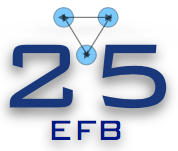Speaker
Description
A hyperspherical cluster model has been developed to describe long-range behaviour of one particle removed from a few- or a many-body system. It has been applied to the ground and first excited states of helium drops with five, six, eight and ten atoms interacting via a two-body soft gaussian potential. Convergence of the hyperspherical cluster harmonics expansion is studied for binding energies, root-mean-squared radii and overlaps of the wave functions of two helium drops differing by one atom. It was shown that with increasing model space the functional form of such overlaps at large distances converges to the correct asymptotic behaviour. The asymptotic normalization coefficients that quantify the overlaps' amplitudes in this region are calculated.
It was also shown that in the first excited state one helium atom stays far apart from the rest forming a two-body molecule, or a halo. The probability of finding the halo atom in the classically-forbidden region of space depends on the definition of the latter and on the binding energy of the valence atom. The total norm of the overlap integrals, the spectroscopic factor, represents the number of partitions of a many-body state into a chosen state of the system with one particle removed. The spectroscopic factors have been calculated and their sum rules are discussed giving a further insight into the structure of helium drops.

